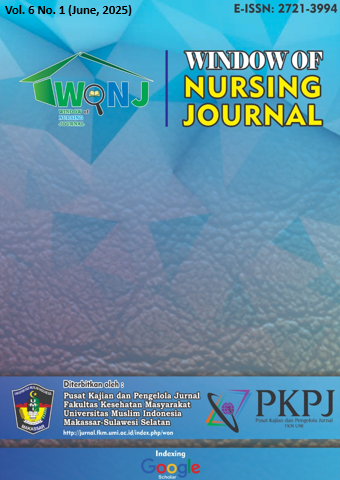Peran Pola Asuh Orang Tua pada Perkembangan Motorik Kasar Anak Usia Prasekolah
DOI:
https://doi.org/10.33096/9sjg6513Keywords:
child development, gross motor skills, parenting styleAbstract
In the process of development, one of the important aspects for the gross motor development of children is body movement which is based on the movement of large muscles, therefore great attention is needed for the development of children's gross motor skills from parents as well as teachers, because children's motoric development is very important in life. children later, the role of parents is very necessary in controlling or monitoring the growth and development of children physically, cognitively or socially. In monitoring children must be regularly and continuously. This study aims to determine the relationship between parenting style and gross motor development of preschool-aged children in kindergarten. Islam Marga Kaya Makassar. This study uses a correlational descriptive research design with a cross sectional study approach. The sampling technique was carried out using a total sampling technique with a total sample of 30 respondents. Data collection using a questionnaire. Methods of data analysis using univariate and bivariate analysis through the Chi-Square statistical test at a significant level of α <0.05. 5 people (16.7%) and children with gross motor development according to as many as 22 children (73.3%) while children with inappropriate categories totaled 8 children (20.0%), statistical tests obtained p value = 0.016 <α value (0.05) . The conclusion in this study is that there is a relationship between parenting parents and children's gross motor development in kindergarten. Makassar Rich Marga Islam. From the results obtained, it is suggested that parents can apply proper parenting, as well as monitor the growth and development of their children from a physical, cognitive and social perspective.
References
Purnamasari IA. Hubungan Pola Asuh Ibu Dengan Kemandirian Anak Usia 3-5 Tahun Di TK Bantengan Kabupaten Madiun Tahun 2018 The Correlation Between Mothers ’ Parenting Pattern And Independence Of Children Aged 3-5 Years Old In Bantengan Kindergarten Madiun In 2018. J Kesehat Madani Med. 2019;10(2):76–84.
Komalasari Wuri. Hubungan pekerjaan dan pendidikan dengan perkembangan bahasa pada anak usia toodler di wilayah kerja puskesmas lubuk buaya padang tahun 2018. J Penelit dan Kaji Ilmu. 2019;XIII(5):169–76.
Yunita D, Luthfi A, Erlinawati E. Hubungan Pemberian Stimulasi Dini Dengan Perkembangan Motorik Pada Balita Di Desa Tanjung Berulak Wilayah Kerja Puskesmas Kampar Tahun 2019. J Kesehat Tambusai. 2020;1(2):61–8.
Prastiwi MH. Pertumbuhan Dan Perkembangan Anak Usia 3-6 Tahun. J Ilm Kesehat Sandi Husada. 2019;10(2):1–8.
Mansur AR. Tumbuh kembang anak usia prasekolah [Internet]. Vol. 1, Andalas University Pres. 2019. 1–86 p. Available from: http://repository.uinjkt.ac.id/dspace/bitstream/123456789/33035/1/Istiqomah Aprilaz-FKIK.pdf
Sembiring E. Hubungan Pola Asuh Orang Tua Dengan Perkembangan Motorik Halus Dan Motorik Kasar Pada Anak Usia 3-6 Tahun Di Desa Namorambe Tahun 2018. J Ners Indones. 2020;VI(02):1–8.
Sulistyo IT, Pudyaningtyas A, Sholeha V. Profil Kemampuan Motorik Kasar Anak Usia 5-6 Tahun. Kumara Cendekia. 2021;9(3):156.
Yuniarti S, Andriyani M. Hubungan Pola Asuh Orang Tua Dengan Perkembangan Anak Prasekolah Di R . A Almardiyah Rajamandala Bulan Juli 2016. Pros Semin Nas Ilmu Pengetah dan Teknol [Internet]. 2017;103–11. Available from: http://lppm.unjani.ac.id/wp-content/uploads/2018/10/103-111-Sri-Yuniarti-STIKES-A-Yani.pdf
Notoatmodjo S. Metodologi penelitian kesehatan. Jakarta : Rineka Cipta; 2018. 243 p.
Aminah S, Wulandari R. Hubungan Antara Pola Asuh Dan Status Gizi Dengan Pekembangan Motorik Kasar Pada Anak Pra Sekolah Desa Sebalor Kecamatan Bandung Kabupaten Tulungagung. J Bidan Pint [Internet]. 2016;1(1). Available from: http://eprints.radenfatah.ac.id/1554/5/BAB II agra.pdf
Munir Z, Yulisyowati Y, Virana H. Hubungan Pola Asuh Orang Tua dalam Menstimulasi Perkembangan Motorik Kasar dan Halus Usia Pra Sekolah. J Keperawatan Prof. 2019;7(1).













